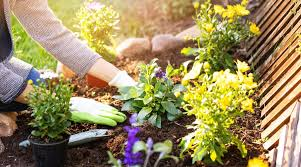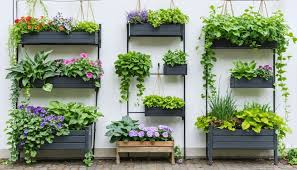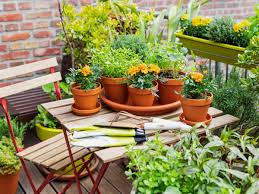No matter the size of your outdoor area—whether it’s a tiny lot, a patio, or an apartment balcony—you can still enjoy the pleasure of growing vegetables, fruits, and ornamental flowers. Gardening in small spaces can be highly rewarding, and with the right approach, you can create a thriving garden without sacrificing space. By starting from seeds, repurposing containers, using vertical planting systems, and selecting compact plant varieties, you can make the most of your limited space.
Design Preparation for Small Gardens
Before diving into what to plant, assess your garden’s sunlight exposure. South- and east-facing areas are ideal for sun-loving plants like vegetables and herbs. For spaces that get less sunlight, such as north- and west-facing areas, consider shade-tolerant plants like coleus, hostas, and ferns.
If you’re gardening on a balcony, check with your building manager regarding any restrictions such as weight limits for pots or whether outdoor plants can stay during the winter. Also, be considerate of your neighbors—ensure that water, soil, and pest treatments don’t spill onto lower floors.
Take measurements of your space and sketch a rough layout on graph paper. This will help you decide where to place plants and whether you want to include seating or a walkway. Keep in mind the mature size of plants (as indicated on seed packets) to avoid overcrowding. For instance, one zucchini plant needs 16 square feet, while a square foot of soil can yield up to 18 carrots. Opt for dwarf or compact plant varieties to save space.

Gardening Methods for Small Spaces
- Beds and Borders
Even a small patch of ground can grow a variety of vegetables and flowers. If space is limited, try planting compact crops like broccoli, cabbage, and marigolds (which also deter pests). For herb gardens, a narrow strip along a patio can be perfect for annual herbs like basil, oregano, and cilantro. - Containers
Container gardening is a quick and easy way to start gardening in small spaces. Containers allow you to grow plants almost anywhere, and they’re ideal for balconies or patios. You can plant vegetables, herbs, and even dwarf shrubs in containers. Be sure to choose the right material—stone and concrete pots are great for colder climates, while plastic and resin pots are lighter and easier to move. When selecting containers, aim for one that’s 2-4 inches wider than the plant and has adequate drainage. You can also repurpose items like birdbaths, old boots, or even a wheelbarrow as unique planters. - Square Foot Gardening
This technique, created by Mel Bartholomew, allows you to grow more in less space by planting in square-foot sections rather than traditional rows. It’s a raised-bed system that requires less water, reduces weeds, and maximizes space. You can plant a variety of vegetables like tomatoes, peppers, and lettuce, ensuring you use compact varieties. This method is perfect for small gardens and can be achieved with minimal materials like cinder blocks or wood to build the raised bed. - Vertical Planting
Vertical gardening is the perfect solution for spaces with minimal ground area. By stacking plants vertically—such as on a trellis, wall-mounted planters, or freestanding structures—you can grow a variety of plants like tomatoes, strawberries, and herbs. This method conserves space while maximizing yield. In addition to specialized vertical planters, you can repurpose old items like shoes, rain boots, or a canvas shoe organizer for a quirky and functional garden. For a more formal look, install vertical systems or even use walls or fences to mount planters.

Getting Your Garden Started
Once you’ve planned your garden, gather the necessary tools and materials. Clean your containers with a mixture of water and bleach to eliminate any harmful pathogens. For in-ground gardening, till the soil to a depth of 8-10 inches, enriching it with compost if needed. Conduct a soil test to check its pH and nutrient levels, and adjust accordingly.
For those using seeds, consider starting them indoors to give your plants a head start, especially if you live in a region with a short growing season. Once the seedlings are ready, gradually acclimate them to outdoor conditions before planting.
No Space Too Small
Remember, even the smallest space can be transformed into a green, vibrant area. From repurposing old furniture as planters to utilizing vertical space for growing, you can create a flourishing garden that’s both beautiful and productive. Whether you want to grow flowers, herbs, or vegetables, small-space gardening offers endless possibilities for creativity and enjoyment.
Start small, plan thoughtfully, and let your garden thrive!
